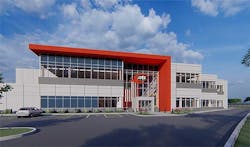In this edition of Voices of the Industry, Sean Baillie, Executive Vice President – Marketing & Connectivity Strategy at QTS Realty Trust discusses the state of the colocation data center industry in an interview with Frost & Sullivan’s Gautham Gnanajothi.
Sean Baillie, Executive Vice President – Marketing & Connectivity Strategy, QTS Realty Trust
Gautham Gnanajothi (Frost & Sullivan) – What are key trends you see having an impact on the colocation services market over the next two to three years?
Sean Baillie (QTS Realty Trust)– First off, our perspective is based on the fact that we serve all verticals — Hyperscale, Government, and Enterprise. The major trend we are seeing is noticeable growth in space and power requirements per engagement that are expanding average deal size in all three segments.
Also, COVID has not slowed demand. We are seeing colocation and connectivity projects at an increasing pace. COVID has created a global remote workforce that is accelerating interaction with digital services in all forms, consumption of video and social media. The underlying digital infrastructure to support all of this growth is what we see in the form of projects and RFPs for space, power and connectivity.
Hyperscale continues to expand. We target about 30 of the world’s largest digital businesses such as Amazon, Google, Microsoft, Facebook, Twitter, et cetera. We define hyperscale as organizations buying large amounts of capacity on a frequent basis.
What was once an average 10-megawatt hyperscale deal three years ago is now 12, 24 and even 36 megawatts and we track this very closely so we can respond accordingly.
In Federal, there is a similar dynamic in terms of increasing requirements for space and power but there is also a trend where Federal organizations reaching end-of-life for their on-premises data centers and are making the strategic decision to move out of those facilities into third-party multi-tenant data centers.
Federal deployment sizes are typically a notch below average hyperscale deals – typically coming in at five to ten-megawatt increments. We have been in the Federal space for over a decade so we have seen the long-range trends. Project release and purchasing has accelerated significantly in the last two years and we expect that to continue for quite some time. In fact, we have just started breaking out and reporting our Federal performance publicly due to the scale that part of our business has achieved.
In the state, local and education (SLED) markets it’s particularly apparent that they are motivated to get out of owned data centers or leases that are coming due in what are typically older buildings. SLED deployments do not have the same scale as the Fed deployments but are following the same pattern of increased project and purchasing volume.
Gautham Gnanajothi – And for the Enterprise?
Sean Baillie – The Enterprise is starting to take steps to join the ranks of those very large and growing Internet businesses. Digitization of the Enterprise, and the resulting digital services, is rapidly increasing requirements for larger technology stacks to store, compute, analyze and connect the data.
Enterprise digital infrastructure deployments are accelerating, expanding and starting to take on junior hyperscale-like requirements for space, power and connectivity. What used to be normal enterprise requests for 250-500 KW environments are now requests for multi-megawatt, multi-site engagements.
And along with the space and power growth, demand for bandwidth of all types also expanding. Requirements for connectivity sophistication is increasing as large enterprises shift to digital models required to get their digital services to more customers on a global scale. This is necessitating direct access to a myriad of internet, IX, cloud, transport and subsea networks.
As a result, enterprises are hiring network and connectivity specialists, and in some cases, hiring them from the hyperscalers. And it stands to reason, because if you’re going to deploy one, two, three, four plus megawatts, and the associated capital required, you want to make very sure that your network strategy is unassailable.
We are seeing it in virtually every discussion with customers and prospects. If you are lacking in dense connectivity ecosystems, and the strategy to expand them, you aren’t going to win with the enterprise. And as you’ve seen from our financial performance we are winning at a healthy rate.
Gautham Gnanajothi – So it sounds like digital transformation is really increasing the importance of connectivity but is probably not as well understood by the enterprise? Can you summarize what you are seeing?
Sean Baillie – That’s exactly right, and you know we’re been very vocal about it.
I think we reached an inflection point this year. Three or four years ago, everything was in a carrier hotel – IP networks; cloud on ramps — you had to buy Metro transport and Metro backhaul – to get to the networks you needed to get to. That has all changed.
The fiber networks have spread out. The switches have spread out and the routers are next. The routers are the ingress and egress to the Internet networks and the cloud networks, and are starting to decentralize beyond carrier hotels and into alternate locations, like QTS. This is a very important trend and will continue. The acceleration of delivering digital services relies on the foundation of internet and cloud architecture. This is what we are ultimately addressing at QTS.
We recently did a deal with a cloud provider to put their core infrastructure in QTS facilities and decentralize out of several carrier hotels. They see what we see as the path forward in fundamental network architecture.
So, I believe we’re going to see a decentralization of the major cloud platforms followed by the IP networks simply because they trade so much traffic with each other and need more locations to do so as each continues to grow their respective networks.
Gautham Gnanajothi – What do you see as we come out of the pandemic?
We’re very bullish when you look at colocation and connectivity demand as a whole. We have a growing pipeline and increasing deal sizes across the board. As an example, between the beginning of 2020 and 2021 our new logo pipeline for enterprise more than doubled in terms of megawatt demand. And I don’t see that changing. I think for the next five to ten years enterprise demand is going to continue to increase.
I think Frost & Sullivan research agrees that enterprise migration out of on-premises data centers into multi-tenant colocation facilities is increasing. Multi-tenant colocation facilities have reached the point in cost effectiveness and efficiency that the idea of enterprises building their own data centers doesn’t make financial or operational sense.
And, we are seeing cloud repatriation move from a hypothesis to a theory, if you take my meaning. At the moment, select large enterprises who have been in the cloud for five or ten years are now facing build versus buy decision give the scale of their workloads. They have been major cloud consumers but have decided they would rather switch to a multi-tenant data center and build their own cloud in those facilities. I’m not saying this is an industry-wide trend, but we are seeing it at the upper end of the enterprise and I think we’re going to keep seeing it.
Gautham Gnanajothi – What would you say are the key competitive factors in the colo services market? Given how competitive it is, what are the key qualities or capabilities that provide an edge to a multi-tenant colo provider in the new digital age?
Sean Baillie – I think that for our three business segments the future is all about scaling to meet rapidly increasing requirements related to digital transformation. Digital transformation is driving them to identify multi-tenant data centers with the ability to rapidly scale their business and that ability to provide expertise and access to highly advanced connectivity ecosystems required to participate in the new global digital economy.
Conversations are starting with questions focused on these areas and they are looking to see if we are proactive about developing solutions mapped to their needs.
Prospects are consistently asking the right questions. Can the colo provider rapidly scale up space and power required for our environment? Do they offer diverse connectivity for cloud and hybrid colocation including carrier-neutral cloud interconnection for AWS, MS Azure and Google clouds, in-building access carriers, multiple entrance facilities and fiber routes, third party neutral internet peering exchanges, and direct access to high capacity, low latency subsea cables becoming increasingly important for global business models?
Software-based visibility and control are also becoming table stakes. QTS was the first colocation provider to become fully-digitized and instrumented for advanced technologies. Our API-driven Service Delivery Platform leverages advancements in AI and ML are improving system reliability, energy efficiency and security while simplifying and reducing operating costs. Customers are interacting with their data and services getting real-time visibility, access and dynamic control of critical metrics across compute and storage environments from a single platform and even from a mobile device. This is becoming a required technology coupled with colocation deployments.
Also emerging is a new emphasis by data centers to provide sustainable IT infrastructure in data centers, powered by renewable energy, whose benefits are shared by enterprise customers in that data center. Enterprises, hyperscalers and the government are all examining providers’ sustainability posture and it is showing up consistently in RFPs. They want to know where their power is being sourced from? What percentage of it is from renewable sources? Are they making public commitments to move to renewable power? We check all those boxes as well.
Sean Baillie is Executive Vice President – Marketing & Connectivity Strategy, at QTS Realty Trust. Gautham Gnanajothi is Global Research Director & Head of Best Practices, Energy & Environment at Frost & Sullivan. Learn more about hybrid and hyperscale colocation by contacting QTS.





